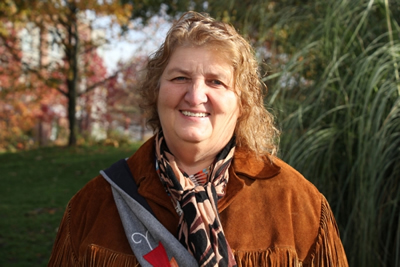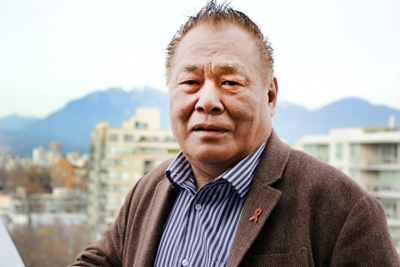Aboriginal AIDS Awareness Week shines a light on HIV rates among indigenous people
 Valerie Nicholson is working on a study looking at barriers
Valerie Nicholson is working on a study looking at barriers
faced by HIV-positive women.
by Yolande Cole on Nov 27, 2013
VALERIE NICHOLSON REMEMBERS the room going silent the day she received her diagnosis.
After the doctor told her she had HIV, she was sent to another room to receive her medication, a place that she
recalls as "the most scary thing in my life". And after the initial revelation, she didn't absorb anything that
followed.
"I remember sitting there: I didn't hear a word she said," Nicholson recalled in an interview with the Georgia
Straight .
It would be another two years before she began taking regular treatment for HIV, a result that she attributes
to barriers to accessing information and education about HIV at the time.
"I was literally on my own," she said. "I fell through the cracks."
When she did return to seek medical treatment, fearing a lecture, her doctor simply told her: "Valerie, let's
get started."
"There was no 'Why haven't you been here in two years?' " Nicholson noted. "I was really near death, and she
saved my life."
Nicholson, an aboriginal woman, has since devoted her time to working with others facing similar barriers,
and is currently helping to recruit and survey HIV-positive women as part of a study of the factors that can
keep them from accessing care.
Angela Kaida, an SFU health sciences assistant professor and a principal investigator for the Canadian HIV
Women's Sexual and Reproductive Health Cohort Study (CHIWOS), noted that women don't fit the typical profile
associated with being HIV-positive.
"Seventy-five percent of people living with HIV in B.C. are men, so that's certainly a reality," she told
the Straight in a phone interview.
"So women are 25 percent of that, but the issues and the priorities for women, of course, are quite different,
and so [it's about] making sure that the services also meet the needs of one in four people who are infected
with HIV."
According to Kaida, some of the typical barriers that women can face in accessing care include poverty,
food insecurity, and unstable housing.
CHIWOS, which is the country's largest longitudinal, community-based study, was launched in October and
will enroll more than 1,250 women living with HIV in B.C., Ontario, and Quebec.
In B.C., a high proportion of women with HIV are aboriginal, Kaida noted.
"Among women, we're really seeing that aboriginal women are overrepresented and disproportionately affected
by HIV," she stated.
"There's been some really thoughtful studies-nationally and, as well, from people working in B.C.-around
some of the reasons for that, and we know about the histories of systemic racialization, ongoing poverty,
the history of residential schools, and the impact it's had on generations of people of aboriginal descent."
The disproportionate number of indigenous people affected by HIV, compared to the general population, is the
focus of Aboriginal AIDS Awareness Week, which launches on December 1, World AIDS Day, in Halifax.

Canadian Aboriginal AIDS Network CEO Ken Clement
is aiming to enhance HIV/AIDS awareness in aboriginal communities.
Ken Clement, CEO of the Canadian Aboriginal AIDS Network (CAAN), pointed out that HIV infection rates are 3.5
times higher in aboriginal communities than among nonaboriginal Canadians.
The focus of this year's awareness week, which concludes on December 6 with an event at the Bill Reid Centre
for Northwest Coast Art Studies, is "getting to zero"-zero new HIV infections, zero discrimination, and zero
AIDS-related deaths.
"We have a long way to go, but at the same time I think an awareness campaign like this always triggers
people to think," Clement told the Straight in an interview.
"We have high youth rates.in the aboriginal communities, and they're the ones we need to ensure get the
message loud and clear. I think this is one way of doing it."
Clement, who is also a school trustee and the first aboriginal politician elected in Vancouver, has been
involved with CAAN for 15 years, acting as CEO for the past five.
As the Ktunaxa First Nation member recounted, it was the loss of his brother Chris, and friends before that,
that prompted him to begin working in the field.
"My brother was HIV-positive," he said. "And the first time we actually knew about it was when he was dying
at St. Paul's [Hospital]."
And he had been living with HIV for about 10 years.
"When I look at my brother's experience.he was probably challenged with issues like stigma, discrimination,
and all those other things, so from that perspective, it made me start thinking of, 'What can I do in a
professional way? How can I contribute?' "
To this day, Clement often thinks of Chris in his work with the organization.
"And not only my brother but the many aboriginal people who have left this world-and, in a lot of cases, sooner
than they should have," he said.
An estimated 8.9 percent of aboriginal people in Canada were living with HIV/AIDS in 2011, and that same year
more than 12 percent of all new HIV infections occurred among aboriginal people, according to Public Health
Agency of Canada data provided by CAAN. Aboriginal people make up less than five percent of the general population.
Injection drug use is the main cause of exposure to HIV for aboriginal people, and aboriginal women and men are
almost equally affected by HIV.
Trevor Stratton, the International Indigenous Working Group on HIV & AIDS coordinator for CAAN, has been
living with HIV since he was diagnosed in 1990.
"I developed AIDS in about 1997 or '98, just after they came out with the new antiretrovirals, and it was the
aboriginal community [that] really reached out to me," he told the Straight in a phone interview.
"I felt like I wasn't the only one. I felt like there are people like me, aboriginal people like me with HIV,
but not only like me: there's babies and grandmothers and just everybody across the spectrum. And it was really
part of my healing to be part of the solution and to be joining the group, taking my rightful place back in
my community and trying to make it better."
Stratton described stigma as "the biggest barrier" facing aboriginal communities when it comes to HIV.
"The more isolated and out there our communities are, the harder it is to get information in or out," he said.
"Because of the legacy of colonization, our communities have had people knocking on the door for centuries,
saying 'We know what's best for you.'
"The trust has been really broken with aboriginal people, and that is a huge barrier for getting information
in and trying to support research," he added. "We have to be very careful not to bulldoze through and to
respect the protocols and the unique culture of each community and make sure that they're onboard and
they help to develop and come up with the solutions that are appropriate for them."
Nicholson noted that in participating as a peer research associate with CHIWOS, she wanted to ensure that the
language being used as part of the survey was culturally respectful.
"The Downtown Eastside is just sort of survey central," she said. "And we call them drive-bys: where they come
in, they wave $20 or $5, you know, and we never see or hear what happened to those surveys. This study, we know
that it's going to come back to our communities."
Kaida explained that many of the peer research associates working on the study come from long-standing service
with community groups that they will be able to relay the information back to.
"The whole point of initiating this type of intensive process is to impact decisions and to make change," she
said. "Including the decision makers and policymakers and community groups and clinicians that actually do
have decision-making power in the process is part of what we think is critical to actually move research
into action."
Given her own experiences, Nicholson is determined to ensure that others don't face the same barriers that
she did. Her goals include setting up an online support network for HIV-positive women and establishing
peer-to-peer counselling at clinics so that patients don't need to be alone when they receive their diagnosis.
"I never want to see another woman, or anyone, fall through the cracks," she said.
###
About the Georgia Straight
Canada's Largest Urban Weekly
No other city publication knows more about Vancouver than the Georgia Straight. Established as the lifestyle and entertainment weekly in
Vancouver for over 40 years, the Georgia Straight is an integral part of the active urban West Coast lifestyle with over 804,000
readers (2009 Angus Reid).
Every Thursday, the Georgia Straight delivers an award-winning editorial package of features, articles, news and reviews. www.straight.com
SOURCE: Georgia Straight
http://www.straight.com/news/538576/aboriginal-aids-awareness-week-shines-light-hiv-rates-among-indigenous-people
"Reproduced with permission - The Georgia Straight"
The Georgia Straight
For more HIV and AIDS News visit...
Positively Positive - Living with HIV/AIDS:
HIV/AIDS News |